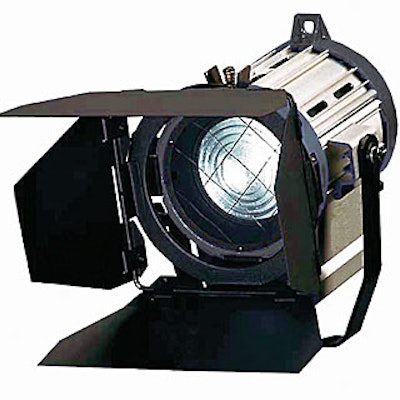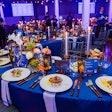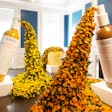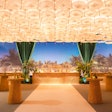1. Flatter Your Guests
When it comes to lighting an event, it’s not enough to make sure the room looks good—your guests need to glow, too. “You have to pick flattering colors,” says lighting designer Bentley Meeker. “You want people to be seen in their best light, so the environment has to be flattering.” That means choosing shades like pink, fuchsia, amber, honey, magenta, or peach. Blues, purples, yellows, and blood red should be used sparingly, he says, and green “is a total no-no.”
2. Match the Mood
“It used to be that you wanted an event to be dark and sexy,” says Liz Garvin, the lighting designer and technical director for Robert Isabell Inc. “But you need to keep in mind the purpose of the event.” In other words, dark and sexy might work for a loungey CD launch party, but doesn’t fit the needs of a corporate meet-and-greet event. Another reason to be wary of the so-dark-you-can’t-see lighting scheme is insurance. “There are a lot of safety.phpects to lighting,” Meeker says, “so make sure you have enough light in the room. That doesn’t mean it has to be bright, but you have to be able to see your shoes.” He recommends having everything on dimmers, so you can easily change the environment. Garvin’s solution: “People need time to get comfortable in a room, so we’ll make it bright enough that they’re comfortable initially, and then dim the lights [later].”
3. Do a Site Inspection
Technical issues are key when it comes to lighting an event space successfully. So make sure your lighting designer does a site inspection before making critical decisions, recommends Dennis Menard, lighting project manager at Scharff Weisberg Inc. “Physically walking into a space and doing a site survey eliminates a lot of problems,” he says. “It’ll tell you exactly what you can and cannot do in that space, where you can put things, how much power there is. All of those things can be settled by going into the space and not necessarily taking the word of the people who run the space.” Menard also always bring more equipment than the original plan requires. “Clients always want something else that was never discussed,” he says.
4. Add Inexpensive Effects
Using moving effects like gobo rotators and scrollers is a good way to create special effects without breaking your budget, says Curt Stahl, coowner of Images by Lighting in Los Angeles. Stahl uses themes like scrolling clouds to lend an ethereal touch to events; floating bubbles for a bit of kitsch; and rippling water to suggest a tranquil environment. And if you’re really on a budget, “use what’s already there, but modify it to fit the event’s theme,” says Guy Smith, of Guy Smith Lighting. For example, place colored gels over existing lighting, or exchange regular light bulbs for colored bulbs: “If the concept is a cold, icy theme, change the lightbulbs to blue.”
5. Light What Guests See
No matter what your budget, Meeker recommends focusing your lighting scheme on what guests see immediately upon walking into the room. “That’s the money moment,” he says. “So make sure that’s the most beautiful perspective in the room. Everything else is secondary.” Of course, that doesn’t mean neglecting the rest of the venue. Meeker also recommends using shadows to your advantage—for example, lighting gorgeous columns and letting shadows hide peeling paint, or focusing light on a beautiful flower arrangement and letting plain white table linens fall into the dark. “Light what you love, and leave everything else in the shadows,” he says.
—Erika Rasmusson Janes
This story originally appeared in the February/March 2005 issue of the BiZBash Event Style Reporter.
When it comes to lighting an event, it’s not enough to make sure the room looks good—your guests need to glow, too. “You have to pick flattering colors,” says lighting designer Bentley Meeker. “You want people to be seen in their best light, so the environment has to be flattering.” That means choosing shades like pink, fuchsia, amber, honey, magenta, or peach. Blues, purples, yellows, and blood red should be used sparingly, he says, and green “is a total no-no.”
2. Match the Mood
“It used to be that you wanted an event to be dark and sexy,” says Liz Garvin, the lighting designer and technical director for Robert Isabell Inc. “But you need to keep in mind the purpose of the event.” In other words, dark and sexy might work for a loungey CD launch party, but doesn’t fit the needs of a corporate meet-and-greet event. Another reason to be wary of the so-dark-you-can’t-see lighting scheme is insurance. “There are a lot of safety.phpects to lighting,” Meeker says, “so make sure you have enough light in the room. That doesn’t mean it has to be bright, but you have to be able to see your shoes.” He recommends having everything on dimmers, so you can easily change the environment. Garvin’s solution: “People need time to get comfortable in a room, so we’ll make it bright enough that they’re comfortable initially, and then dim the lights [later].”
3. Do a Site Inspection
Technical issues are key when it comes to lighting an event space successfully. So make sure your lighting designer does a site inspection before making critical decisions, recommends Dennis Menard, lighting project manager at Scharff Weisberg Inc. “Physically walking into a space and doing a site survey eliminates a lot of problems,” he says. “It’ll tell you exactly what you can and cannot do in that space, where you can put things, how much power there is. All of those things can be settled by going into the space and not necessarily taking the word of the people who run the space.” Menard also always bring more equipment than the original plan requires. “Clients always want something else that was never discussed,” he says.
4. Add Inexpensive Effects
Using moving effects like gobo rotators and scrollers is a good way to create special effects without breaking your budget, says Curt Stahl, coowner of Images by Lighting in Los Angeles. Stahl uses themes like scrolling clouds to lend an ethereal touch to events; floating bubbles for a bit of kitsch; and rippling water to suggest a tranquil environment. And if you’re really on a budget, “use what’s already there, but modify it to fit the event’s theme,” says Guy Smith, of Guy Smith Lighting. For example, place colored gels over existing lighting, or exchange regular light bulbs for colored bulbs: “If the concept is a cold, icy theme, change the lightbulbs to blue.”
5. Light What Guests See
No matter what your budget, Meeker recommends focusing your lighting scheme on what guests see immediately upon walking into the room. “That’s the money moment,” he says. “So make sure that’s the most beautiful perspective in the room. Everything else is secondary.” Of course, that doesn’t mean neglecting the rest of the venue. Meeker also recommends using shadows to your advantage—for example, lighting gorgeous columns and letting shadows hide peeling paint, or focusing light on a beautiful flower arrangement and letting plain white table linens fall into the dark. “Light what you love, and leave everything else in the shadows,” he says.
—Erika Rasmusson Janes
This story originally appeared in the February/March 2005 issue of the BiZBash Event Style Reporter.




















